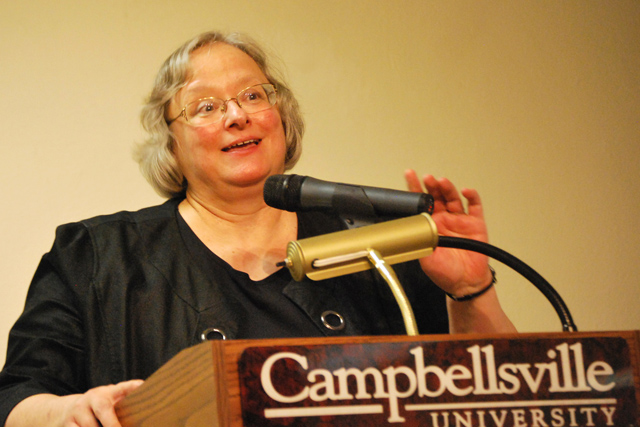Oct. 20, 2010
For Immediate Release
 |
| Dr. Ann Mann Millin, United States Holocaust Memorial Museum historian, speaks at a Campbellsville University Kentucky Heartland Institute on Public Policy (KHIPP) event featuring the Holocaust. (Campbellsville University Photo by Munkh-Amgalan Galsanjamts) |
By Joan C. McKinney, news and publications coordinator
CAMPBELLSVILLE, Ky. – Adolf Hitler said: “Propaganda is a truly terrible weapon in the hands of an expert” in 1924.
Dr. Ann Millin, historian and special assistant to the director of the leadership programs in the United States Holocaust Memorial Museum’s National Institute for Holocaust Education in Washington, D.C., discussed how Hitler used propaganda during his reign in Germany at a Kentucky Heartland Institute on Public Policy (KHIPP) event Oct. 12 at Campbellsville University.
Millin talked about the museum’s exhibit “State of Deception: The Power of Nazi Propaganda” which, because of its popularity, has been extended until 2013. She said the exhibit has had 22 million visitors.
Millin said the exhibit reveals how the Nazi Party used modern techniques as well as new technologies and carefully crafted messages to sway millions with its vision for a new Germany.
She showed slides of different posters used as Hilter spread his propaganda throughout the world during 12 years of persecution and genocide when about six million Jews were killed.
Millin said the power of propaganda depends on the message, the technique, means of communication, the environment and the audience’s reception.
She said propaganda can be both good and bad, and “The Nazis were extremely skilled” in the use of propaganda.
Hitler used new art techniques for posters and other messages which connected to the youth. He used ‘floating heads’ in his designs on posters and also on the new medium of TV.
“Propaganda works with the conscious and unconscious hopes, fears and desires of people,” Millin said. Hitler, at first, didn’t appeal to women, but his use of women and children in his messages began to secure women for his cause.
One of his techniques would be to fly from place to place and throw paper swastikas from the airplane to litter the land and for children to play with. Propaganda leaflets to soldiers were also decimated in this manner.
He would use sound bytes in which he would ask what the public was afraid of and would suggest that Hitler was the last hope.
“His efforts were compelling and appealing,” Millin said. “He would use testimonies of plain folks to transfer ideas of logical fallacies to everyone.”
Hitler used name calling also and glittering generalities. He was the first to use photographs on political posters, and he engaged the youth, women and men in this matter.
She said Hitler used pictures of snakes, lice, cockroaches and other vermin to insinuate they were the Jews. She said propaganda, when abused or used for the wrong purposes, is “truly a terrible weapon.”
Millin said denial of the Holocaust is one of the greater problems the museum works with, and the different exhibits, programs, literature etc. hopefully will help educate the public.
She said the mandate and mission of the United States Holocaust Memorial Museum is to memorialize the victims of the Holocaust and to honor the survivors and to encourage its visitors to reflect upon the moral and spiritual questions raised by the events of the Holocaust as well as their own responsibilities as citizens of a democracy.
In order to prevent genocide and remember the Holocaust victims, “What you do matters,” Millin said. “You must go and remember.”
“The Holocaust was not inevitable and did not take place in isolation from society. People had choices, and the choices had consequences,” she said.
To learn more about the United States Holocaust Memorial Museum, go to www.ushmm.org.
Campbellsville University is a widely acclaimed Kentucky-based Christian university with over 3,000 students offering 63 undergraduate programs, 17 master’s degrees and five postgraduate areas. The website for complete information is campbellsville.edu.
